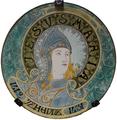Faïencerie de Lunéville-Saint-Clément
Coordinates: 48 ° 31 '48.4 " N , 6 ° 36' 1.8" E
The Faïencerie de Lunéville-Saint-Clément has preserved the heritage of the Lorraine town of Lunéville and the commune of Saint-Clément of earthenware production since the 18th century. The Lunéville factory was founded around 1730, while that of Saint-Clément was founded around 1758, making it the oldest faience factory still in operation .
history
The origins of the manufacture go back to the year 1711, in which (Jean) -Jacques Chambrette père (1683–1751), a master potter from Dijon, founded the first pottery in Lorraine near Champigneulles on behalf of the Comte de Fontenoy. The history of earthenware began in Luneville in 1722, when his son Jacques Chambrette (1705–1758) established himself as an earthenware dealer. In 1723 he became the farm's supplier. It wasn't until 1729 or maybe 1730 that Jacques Chambrette fils opened his first earthenware factory there. However, he did not receive his official letter patent from Duke François III until April 10, 1731, so that he could obtain land and wood wherever he wanted, and received tax exemptions from Élisabeth-Charlotte d'Orléans on June 14, 1731.
At the same time, Jacques Chambrette teamed up with a certain Daix in 1739 to take over the Portieux glass factory.
After developing the Terre de Pipe (with chalk or lime marl, burnt white) - a secret composition that was transferred to the Faïencerie de Niderviller by one of his grandchildren - and then the Terre de Lorraine (with calcium phosphate), soils, resulting in a fine and white earthenware that made it possible to obtain fine details, technique from England to imitate porcelain, which is why it is sometimes called "opaque porcelain", and finer and more colorful decorations by cooking in the steamed oven "Réverbère" (small fire) shows Jacques Chambrette the refinement of his new productions by his girlfriend Émilie du Châtelet and King Stanislaus I. Leszczyński . The latter then granted her a new letter patent on December 13, 1749, with the right to extract her raw material from all open spaces in Lorraine, and then authorization to distinguish her from the Manufacture Royale. This development made it possible to increase exports to Germany, Poland, Italy and even to the colonies. By 1753, around 200 workers were already employed there.
However, in order to avoid the high taxes on exports from the Duchy of Lorraine to France, Jacques Chambrette founded after a request to King Louis XV. 1756 (official authorization from January 3, 1758) a second factory in Saint-Clément, located in the Trois-Évêchés area.
When Jacques Chambrette died, his son Gabriel (1732–1788) and his son-in-law Charles Loyal took over the two factories of Lunéville & Saint-Clément.
Work pieces
Lunéville Gallery
Chien de Fô from Luneville (Hallwyl Museum in Stockholm ) around 1760.
Statuette "femme couronnant un musicien" - Terre de Lorraine with enamel containing tin, Luneville, around 1775, - Musée national de Céramique - Sèvres , inv no. MNC 3756
Chocolatière XIXe Musée de la céramique et de l'ivoire de Commercy .
Auguste Majorelle , ornamental crockery made of Lunéville stoneware, second half of the 19th century
Ernest Bussière (1863–1913) et KELLER & GUERIN (Lunéville) Vase Périanthe.
Vase en faïence fine de petit feu. Couverte émaillée irisée à reflets métalliques, mat et brillant
Signé sous la base à l'émail KG Lunéville - Bussière - fin du XIX e siècle.Assiette en faïence de Lunéville, détail du décor, modèle Andilly pour la Samaritaine , vers 1920.
Saint-Clément Gallery
- Faïences de Saint-Clément
Panier fleuri au Musée Charles-de-Bruyères .
Assiette ajourée "fidèle à son nid" (1914) au Musée lorrain .















